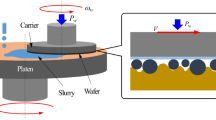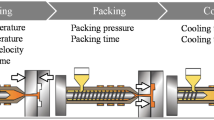Abstract
Electrical discharge machining (EDM) is widely used in mold manufacturing to form the intricate geometric features which are difficult to be produced by the conventional machining process. Owing to the use of a large number of electrodes, the cost and time consumption for electrode design and NC programming has become a bottleneck in boosting productivity of mold enterprises. Although computer-aided design (CAD)/computer-aided manufacturing (CAM) systems are widely used, because of the complex shapes and diversity of electrodes, manual operations are commonly employed to generate process plans and tool paths for electrode manufacturing, which is cumbersome and error-prone. In order to realize the intelligent manufacturing of electrodes in such a knowledge-intensive domain, this paper presents a feature-based integration approach of CAD/computer-aided process planning (CAPP)/CAM. A hierarchical taxonomy of electrode features is introduced and a hybrid feature recognition method is proposed to build multi-level feature tree. Then, feature knowledge and domain know-how based process planning and optimization are achieved followed by automatic tool path generation which aim to machining the electrode precisely and economically. In the framework of system integration, a structured product model is established to capture and encapsulate geometric entities, machining features, technical information, process plans, and measurement data of machining error to realize seamless flow of information among CAD/CAPP/CAM systems. The effectiveness and efficiency of the proposed approach are demonstrated by case studies and industry implementation.
Similar content being viewed by others
References
Ding XM, Fuh JYH, Lee KS, Zhang YF, Nee AYC (2000) A computer-aided EDM electrode design system for mold manufacturing. Int J Prod Res 38(13):3079–3092
Jha B, Ram K, Rao M (2011) An overview of technology and research in electrode design and manufacturing in sinking electrical discharge machining. J Eng Sci Technol Rev 4(2):118–130
Xu T, Chen Z, Li J, Yan X (2015) Automatic tool path generation from structuralized machining process integrated with CAD/CAPP/CAM system. Int J Adv Manuf Technol 80(5–8):1097–1111
Zhou X, Qiu Y, Hua G, Wang H, Ruan X (2007) A feasible approach to the integration of CAD and CAPP. Comput Aided Des 39(4):324–338
Miao HK, Sridharan N, Shah JJ (2002) CAD-CAM integration using machining features. Int J Comput Integr Manuf 15(4):296–318
Sivakumar S, Dhanalakshmi V (2013) An approach towards the integration of CAD/CAM/CAI through STEP file using feature extraction for cylindrical parts. Int J Comput Integr Manuf 26(6):561–570
Xie SQ, Xu X (2006) A STEP-compliant process planning system for sheet metal parts. Int J Comput Integr Manuf 19(6):627–638
Mawussi KB, Tapie L (2011) A knowledge base model for complex forging die machining. Comput Ind Eng 61(1):84–97
Lin BT, Kuo CC (2006) Application of an integrated CAD/CAE/CAM system for stamping dies for automobiles. Int J Adv Manuf Technol 35(9–10):1000–1013
Lee YH, Li CL (2009) Automation in the design of EDM electrodes. Comput Aided Des 41(9):600–613
Geng W, Chen Z, He K, Wu Y (2016) Feature recognition and volume generation of uncut regions for electrical discharge machining. Adv Eng Softw 91:51–62
Verma AK, Rajotia S (2010) A review of machining feature recognition methodologies. Int J Comput Integr Manuf 23(4):353–368
Sunil VB, Agarwal R, Pande SS (2010) An approach to recognize interacting features from B-Rep CAD models of prismatic machined parts using a hybrid (graph and rule based) technique. Comput Ind 61(7):686–701
Gao S, Shah JJ (1998) Automatic recognition of interacting machining features based on minimal condition subgraph. Comput Aided Des 30(9):727–739
Rahmani K, Arezoo B (2007) A hybrid hint-based and graph-based framework for recognition of interacting milling features. Comput Ind 58(4):304–312
Yusof Y, Latif K (2014) Survey on computer-aided process planning. Int J Adv Manuf Technol 75(1–4):77–89
Göloğlu C (2004) A constraint-based operation sequencing for a knowledge-based process planning. J Intell Manuf 15(14):463–470
Liu Z, Wang L (2007) Sequencing of interacting prismatic machining features for process planning. Comput Ind 58(4):295–303
Chen WL, Xie SQ, Zeng FF, Li BM (2011) A new process knowledge representation approach using parameter flow chart. Comput Ind 62(1):9–22
Liang JS (2010) A troubleshooting process planning using knowledge base and distributed database approach. Int J Adv Manuf Technol 54(5–8):701–719
Leo Kumar SP, Jerald J, Kumanan S (2015) Feature-based modelling and process parameters selection in a CAPP system for prismatic micro parts. Int J Comput Integr Manuf 28(10):1046–1062
Liang M, Ahamed S, Van Den Berg B (1996) A STEP based tool path generation system for rough machining of planar surfaces. Comput Ind 32(2):219–231
Hou M, Faddis TN (2006) Automatic tool path generation of a feature-based CAD/CAPP/CAM integrated system. Int J Comput Integr Manuf 19(4):350–358
Chen HC, Yau HT, Lin CC (2011) Computer-aided process planning for NC tool path generation of complex shoe molds. Int J Adv Manuf Technol 58(5–8):607–619
Leo Kumar SP (2018) Automation of tool path generation in multi-process micromachine tool for micromachining of prismatic and rotational parts. Int J Comput Integr Manuf 31(1):49–70
Li WD, Ong SK, Nee AYC (2002) Hybrid genetic algorithm and simulated annealing approach for the optimization of process plans for prismatic parts. Int J Prod Res 40(8):1899–1922
Hua G, Zhou X, Ruan X (2006) GA-based synthesis approach for machining scheme selection and operation sequencing optimization for prismatic parts. Int J Adv Manuf Technol 33(5–6):594–603
Author information
Authors and Affiliations
Corresponding author
Rights and permissions
About this article
Cite this article
Ma, H., Zhou, X., Liu, W. et al. A feature-based approach towards integration and automation of CAD/CAPP/CAM for EDM electrodes. Int J Adv Manuf Technol 98, 2943–2965 (2018). https://doi.org/10.1007/s00170-018-2447-2
Received:
Accepted:
Published:
Issue Date:
DOI: https://doi.org/10.1007/s00170-018-2447-2




